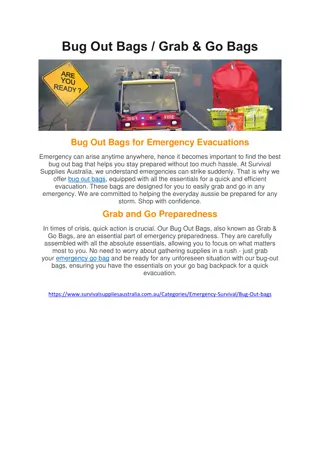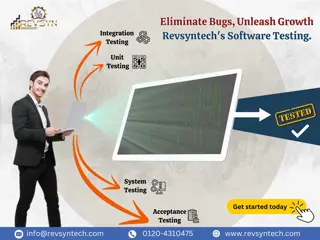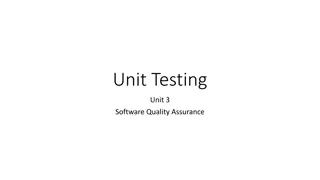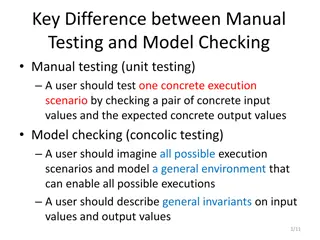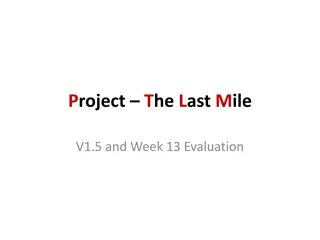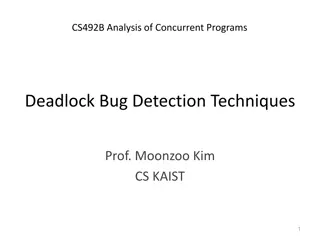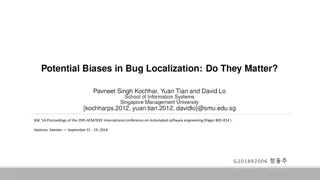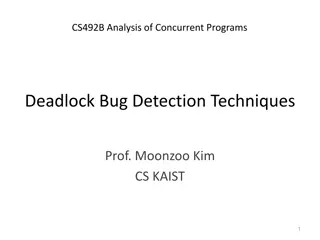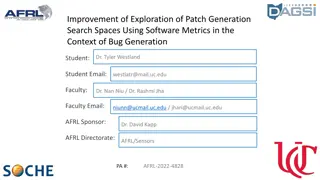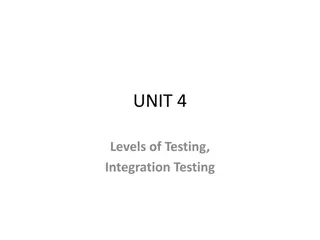Comprehensive Bug Hunting Toolkit for Cybersecurity Enthusiasts
Explore a detailed guide on bug hunting tools, techniques, and resources by expert bug hunter Orwa Atyat from Jordan. Learn valuable tips on finding high/critical bugs, conducting basic recon, subdomain enumerations, collecting URLs/endpoints, and searching for backup files. Enhance your cybersecuri
2 views • 14 slides
Bug Out Bags https://www.survivalsuppliesaustralia.com.au/Categories/Emergency-S
Bug Out Bags for Emergency Evacuations\nEmergency can arise anytime anywhere, hence it becomes important to find the best bug out bag that helps you stay prepared without too much hassle. At Survival Supplies Australia, we understand emergencies can strike suddenly. That is why we offer bug out bags
1 views • 1 slides
Eliminate Bugs, Unleash Growth Revsyntech's Software Testing.
Unit Testing\nIntegration Testing\nSystem Testing\nAcceptance Testing\nEliminate Bugs and unleash Growth of Revsyntech's Software Testing.
2 views • 1 slides
Fighting Bed Bugs NYC Bed Bug Treatments and Exterminators
Infestations of bed bugs in NYC must be dealt with quickly and effectively to stop them from growing and causing more discomfort. Both homeowners and businesses may reclaim their spaces from these stubborn pests by selecting the best bed bug exterminator, implementing tried-and-true treatment proced
2 views • 8 slides
Software Quality Assurance: Understanding Unit Testing and Boundary Value Testing
Unit testing is a crucial method in software development to ensure each part of the program behaves as intended. It helps detect problems early and provides a written contract for code quality. Additionally, Boundary Value Testing is a black box technique that focuses on input domain testing, with a
1 views • 49 slides
Fundamentals of Software Testing: Quiz on Testing Principles
This quiz focuses on fundamental concepts in software testing, covering topics such as test conditions, testing objectives, differences between testing and debugging, and common failure scenarios. Questions are structured to assess understanding of key principles and objectives in software testing.
1 views • 26 slides
Understanding Software Testing Metrics and Tools
Software testing metrics play a crucial role in evaluating the quality and progress of the testing process. Metrics provide valuable insights into the readiness, quality, and completeness of a product. By measuring attributes such as defects, testing efficiency, and productivity, organizations can m
3 views • 100 slides
Fundamentals of Software Testing Explained
Software testing is a critical process to ensure that software applications meet requirements and are free of defects. It involves various activities such as test planning, analysis, design, implementation, and execution. Testing approaches like the Bing bang approach and Total Quality Management ar
1 views • 48 slides
Understanding Equivalence Class Testing and Its Application in Software Testing
Equivalence class testing is a software testing technique that involves dividing input values into classes for effective testing coverage. Equivalence classes are defined mathematically as subsets of a given set, ensuring partitioning and mutual exclusivity. By applying equivalence partitioning, tes
1 views • 21 slides
Uganda's Successes in Reaching Men with HIV Testing Through Assisted Partner Notification Program
Uganda has successfully implemented an Assisted Partner Notification (APN) program to reach men for HIV testing, addressing the gender gap in testing rates. By utilizing various approaches such as index testing, self-testing, and social network testing, Uganda has achieved significant success in tar
0 views • 12 slides
Software Testing Foundation Level: Testing Throughout the SDLC Quiz
Explore key concepts in software testing throughout the Software Development Lifecycle (SDLC) with a quiz covering topics like white-box testing in acceptance testing, component testing vs. system testing, and regression testing purposes. Enhance your understanding of testing methodologies with samp
5 views • 17 slides
Importance of Software Testing in Preventing Catastrophic Failures
Software testing is crucial in ensuring the reliability and safety of software systems, as highlighted by catastrophic failures such as the Ariane 5 rocket incident and the Therac-25 radiation therapy machine disasters. These examples underscore the importance of thorough testing in identifying and
1 views • 42 slides
Testing Approach in SCREAM for E3SM Fall All-Hands 2019
Major effort is focused on verification and testing in SCREAM for the E3SM Fall All-Hands. The initiative includes unit testing, property testing, regression testing, and leveraging various tools like Cmake, Python, Jenkins, AutoTester, and GitHub for Continuous Integration (CI). The emphasis is on
1 views • 21 slides
Difference Between Manual Testing and Model Checking
Manual testing focuses on testing specific scenarios with concrete inputs and outputs, while model checking involves imagining all possible scenarios to create a general environment for testing. In manual testing, users test specific execution scenarios, whereas in model checking, users envision and
2 views • 4 slides
Real-World Concurrency Bugs and Detection Strategies
Explore the complexities of real-world concurrency bugs through a study of 105 bugs from major open-source programs. Learn about bug patterns, manifestation conditions, diagnosing strategies, and fixing methods to improve bug detection and avoidance. Gain insights from methodologies evaluating appli
0 views • 20 slides
Implementation of LFD Testing in Workplace Settings
Introduction to LFD testing in workplaces covers foundational principles, steps to set up a testing service for employees, and roles/responsibilities of stakeholders. Employers must ensure testing is adaptable to different settings, observed/supervised, and recorded. The process involves engaging em
2 views • 7 slides
Zimbabwe HIV Viral Load Testing Overview
Zimbabwe's plan to scale up HIV viral load testing from 2018 to 2020 is outlined, with targets set for each year. The country has made significant progress in expanding its viral load testing capacity, going from targeted testing to near-universal coverage by 2018. Various testing laboratories in Zi
0 views • 9 slides
Last Mile Project Evaluation and Aftermath Guidelines
The Last Mile Project V1.5 and Week 13 Evaluation involve submission deadlines, tutorial and lecture timeslots, user acceptance testing, peer evaluations, and bug resolution processes. Peer evaluations are essential for testing multiple products with varied features, providing insights and improving
0 views • 6 slides
Antigen Testing in Higher Education Institutions
Antigen testing strategies are recommended for institutions of higher education, with rapid results provided by CareStart COVID-19 Antigen Tests. The testing procedure involves sample collection and interpretation of results, including criteria for validity and different outcomes. Regular testing ca
0 views • 13 slides
Evolution of Antimicrobial Susceptibility Testing in Veterinary Medicine
Antimicrobial Susceptibility Testing (AST) in veterinary medicine has transitioned from limited usage to targeted therapy with species-specific clinical breakpoints. Current challenges include low testing frequency and the need for more reliable, rapid, and cost-effective testing methods. Incentives
0 views • 32 slides
Discovering Techniques for Detecting Deadlock Bugs in Concurrent Programs
This analysis delves into various bug detection techniques for concurrent programs, focusing on deadlock bugs. It explores model checking and testing techniques, discussing their precision, error detection capabilities, and scalability challenges. The prevalence of deadlock bugs in real-world applic
0 views • 35 slides
Understanding the Dynamics of Collision: Bug vs. Windshield
Explore the intriguing physics behind a bug hitting a windshield, delving into concepts like Newton's third law, momentum conservation, and the differences in force, time of impact, and change in velocity. Discover why a bug goes splat while a windshield remains intact in a collision scenario, with
0 views • 19 slides
Investigating Biases in Bug Localization Studies: A Critical Analysis
This research delves into potential biases affecting bug localization studies in software development. It explores misclassification of bug reports, pre-localized reports, and issues with ground truth files, shedding light on the challenges in accurately predicting and localizing software bugs.
0 views • 47 slides
Understanding Probabilistic Concurrency Testing for Bug Detection
Explore the concept of probabilistic concurrency testing and how randomized scheduling algorithms can help detect bugs efficiently. Learn about bug depth, randomized algorithms, and the development of PCT to improve the effectiveness of stress testing tools like Cuzz.
0 views • 23 slides
Investigating Biodiversity in the Schoolyard Garden
The Bug Blitz project aims to investigate the biodiversity of the schoolyard garden by capturing and documenting different bug species. The project involves identifying bugs, taking detailed photographs, and ensuring data accuracy. Specific procedures and methods are outlined for data collection wit
0 views • 15 slides
Formal Guarantees for Localized Bug Fixes: A Methodological Review
This review delves into a formal method for verifying bug fixes, specifically focusing on ensuring robustness and scalability in bug identification and classification. The OpenSPARC Story unfolds a methodology for bug fix verification, emphasizing bug resurfacing prevention and fix classification ba
0 views • 16 slides
Techniques for Detecting and Analyzing Deadlock Bugs in Concurrent Programs
Analysis of deadlock bug detection techniques in concurrent programs, highlighting the prevalence of deadlock bugs in real-world applications. The content discusses various bug detection approaches, including model checking and testing techniques, along with the challenges and solutions related to s
0 views • 32 slides
Challenges and Solutions in Concurrency Testing with Randomized Algorithms
Concurrency testing in complex cloud services presents challenges such as bugs, performance problems, and data loss. Randomized algorithms, like Probabilistic Concurrency Testing (PCT), offer effective bug-finding solutions. PCT provides probabilistic guarantees and scalable bug detection for distri
0 views • 37 slides
Kiwanis BUG Program - Empowering Students for Academic Success
The Kiwanis BUG Program aims to empower students to excel academically by recognizing their efforts in improving or maintaining good grades. Through a structured program, students are motivated to set goals, show perseverance, engage in peer mentoring, and receive support from teachers. Governor Mar
0 views • 45 slides
Understanding Testing in Software Engineering
In the previous session, we discussed various aspects of software engineering, including modeling with UML diagrams, such as activity diagrams, use case diagrams, sequence diagrams, state diagrams, and class diagrams, as well as architecture patterns. Testing was emphasized as a key aspect, highligh
0 views • 35 slides
Understanding Gray Box Testing in Software Development
Gray Box Testing is a software testing technique that involves testing the software with partial knowledge of its internal workings. It combines aspects of White Box Testing and Black Box Testing, allowing testers to check both the presentation layer and the code part of an application. Gray Box Tes
0 views • 14 slides
Lessons Learned from Commercializing a Bug Finding Tool
Coverity, a brand of software tools, transitioned static code analysis to the real world through customer interactions, bug finding laws, and bug handling strategies. Lessons include the impact of lab vs industry settings, customer trials, and understanding bugs in a code base. The importance of acc
2 views • 8 slides
Understanding Requirements-Based Testing in Software Development
Dive into the world of requirements-based testing in software development, exploring main concepts, test levels, testing roles, and the importance of testing your solution and modeling case. Learn about test cases, different testing activities, and the significance of acceptance testing in identifyi
0 views • 16 slides
Software Bug Localization with Markov Logic
Software bug localization techniques like Tarantula focus on finding likely buggy code fragments in a software system by analyzing test results, code coverage, bug history, and code dependencies. The lack of an interface layer in existing techniques leads to handcrafted heuristics, posing a persiste
0 views • 17 slides
Guidelines for HIV Testing During Pregnancy and Postpartum
These guidelines recommend HIV testing during pregnancy, at delivery, and postpartum. Testing should be done early in pregnancy and again in the third trimester. Expedited testing during labor is required for certain patients, and syphilis testing is recommended. Pre-exposure and post-exposure proph
0 views • 18 slides
Exploration of Patch Generation Search Spaces using Software Metrics
This research focuses on improving the exploration of patch generation search spaces by utilizing software metrics in the context of bug generation. The study investigates the threat of malicious code insertion in third-party code construction for military projects and explores the concept of Patch
0 views • 8 slides
Comprehensive Overview of Fault Modeling and Fault Simulation in VLSI
Explore the intricacies of fault modeling and fault simulation in VLSI design, covering topics such as testing philosophy, role of testing in VLSI, technology trends affecting testing, fault types, fault equivalence, dominance, collapsing, and simulation methods. Understand the importance of testing
0 views • 59 slides
Understanding Unit Testing in Software Engineering
Concept Software is a discipline comprising various code pieces. Testing these codes together is complex but vital in Software Engineering. The process includes early testing like unit tests, pairwise/multiple component testing, module testing, integration testing, user tests, alpha tests, beta test
0 views • 6 slides
Overview of Static Bug Detection in Software Quality Assurance
Static bug detection is a less popular but effective approach for software quality assurance compared to traditional testing methods. It involves tools like Findbugs that help identify potential issues in code before deployment, such as bad coding styles, null pointer dereferences, and malicious cod
0 views • 36 slides
Understanding Integration Testing and Levels of Testing
Explore the importance of integration testing in software development, covering topics such as traditional testing levels, the SATM system, goals and purposes of integration testing, testing level assumptions and objectives, software process overview, various approaches to integration testing, and t
0 views • 39 slides

